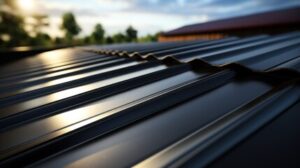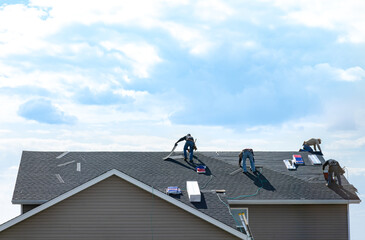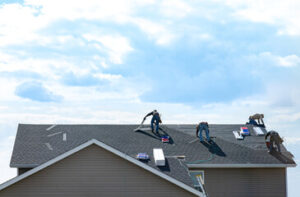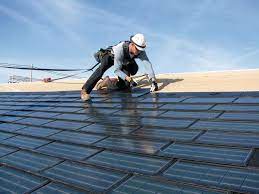Roofs are exposed to a wide range of environmental factors, and they can develop various issues over time. These include missing shingles, sagging, and leaks.
Proper maintenance and regular inspections can help prevent these issues from developing. This includes cleaning gutters, ensuring vents are clear, and removing moss. It’s also important to ensure proper attic ventilation. Contact Victory Roof Repair Las Vegas NV for professional help.
Aside from being a cosmetic issue, cracking or torn shingles can allow water through your roof and damage your interior. This problem is common and easy to fix with roofing sealant, which you can purchase at most hardware stores. To repair a cracked shingle, apply a thick bead of sealant underneath the crack. Press the shingle down and spread the sealant with a putty knife. Leave the shingle weighed down for at least 24 hours to ensure it completely sets.
Cracked shingles can be caused by weather exposure, extreme heat, or even natural aging of the shingle materials. Other causes of shingle damage include improper installation, lack of professional maintenance, and the buildup of debris on your roof.
To prevent shingle damage, it is essential to regularly inspect your roof. Look for signs of moisture damage, such as water stains on your ceiling and walls or increased energy bills due to leaks. A professional can perform a full roof inspection to identify and address any minor problems before they become major issues.
Other common shingle issues include sun bleaching (which lightens the color of your shingles), and blistering, which occurs when moisture becomes trapped underneath a shingle surface. Blistering is a sign of an unhealthy roof and should be addressed by your local roofing contractor.
Cracked, torn, and missing shingles all pose a significant risk to your home. If left unattended, these problems can lead to leaks, structural damage, and mold growth in your home. To keep your roof in top condition, it is important to regularly perform inspections and follow a schedule of professional maintenance by a qualified roofing contractor. For your safety, always wear appropriate footwear and use a sturdy ladder when conducting a roof inspection. Also, consider having a reflective roof coating applied to reduce energy costs and protect your shingles from damaging UV rays.
Gaps
Gaps between the roof and gutter system are a common issue that can cause costly damage to a home. The gap allows rainwater to escape into the siding or foundation of a home instead of flowing through the gutter and downspouts. Gaps between the gutter and roof are usually caused by poor gutter installation or by the aging of a roof. However, gaps can also be the result of a builder’s gap or by the presence of sagging gutters. Gaps between the roof and gutter system should be repaired promptly to prevent water damage and other serious problems.
Before attempting to repair the gap, it is important to clean off the area with a ladder and gloves. This will allow you to see the flashing more clearly and will prevent dirt, debris, or snow from accumulating in the gap. Also, be sure to inspect the gutters to ensure they are properly attached to the roof and are not pulling away from the house.
Once the area has been cleaned, you can begin to fix the gap with roofing cement or caulking. If necessary, you can also use a gutter expansion gap filler to seal the hole. The gap filler is available at most home improvement stores and can be installed with little difficulty.
In addition to preventing leaks, the gap between the roof and gutters can help with attic ventilation. The gap allows warm air to rise from the eaves and exit through the roof ridge, while cooler attic air flows into the soffits and out through the vents. This is known as passive ventilation and is an essential aspect of a well-maintained roof.
Gaps between the roof and gutter can also lead to drainage issues. Gutter gaps may not drain properly, causing water to back up under the shingles and deteriorate the roof structure over time. The best way to avoid these problems is to hire a professional gutter installer to properly install and pitch your gutters. Also, be sure to check for loose sections of flashing and repair them as needed.
Leaks
When water seeps through a roof, it can cause serious damage to insulation, walls, ceilings, and floors. Water ingress can also rot rafters and ceiling joists, causing structural problems in your home. It can even lead to harmful mold growth. Fortunately, if you spot a leaky roof early on, it’s fairly easy to repair.
First, check the area inside your house to locate the source of the leak. Look for stains or discoloration on the walls, ceilings, and floor. You may also notice signs of moisture in the attic or walls, including mold growth. If you can’t locate the source of the leak, it’s important to thoroughly inspect the roof and attic spaces. Look for areas around chimneys, old flashing, pipes, vents, skylights, and other possible entry points.
If you can’t locate the source of a leak, start by covering it with a tarp or heavy plastic sheeting to prevent further damage to your home. You can also use roofing tape to create a temporary patch for small holes or punctures. For a more permanent solution, you can also install a waterproof membrane, which is typically installed over the affected area and secured with caulk or roofing nails.
Before applying any repair materials, make sure the surface is clean and free of rust or other debris that could interfere with adhesion. If necessary, remove any moss or vegetation growing on the roof as well.
Once the area has been cleaned, apply a generous amount of roof sealant or caulk to the nail hole or crack. Make sure the material is applied evenly and smoothed out using a putty knife. Let the sealant or caulk dry according to manufacturer’s instructions before exposing it to moisture again.
It’s also important to regularly clear away debris from the roof, especially after storms or heavy rains. Debris can block drains and gutter systems, leading to standing water that increases the risk of leaking and other damage. Regularly clearing debris can help prevent structural strain and rotting, as well as reduce the need for costly repairs in the future.
Sagging
A solid roof is crucial to protect your home, keep out the weather, and provide structural integrity. But a sagging roof is more than just an eyesore; it can be dangerous for your family and indicate underlying problems that threaten the entire structure of your home. If left unchecked, a sagging roof can cause significant damage and collapse.
A sagging roof may be caused by a number of issues, including overloading, structural problems, or poor design. A thorough inspection can help determine the root cause and necessary repairs. Common methods of repairing a sagging roof include sistering the rafters, adding bracing, or installing support brackets. In some cases, replacing rotting or pest-damaged wood will also be required.
Sagging in one part of the roof is usually a sign that there’s an issue with the trusses and rafters. In these cases, it’s important to find out the cause of the problem and fix it as soon as possible.
Another common reason for sagging is excess weight, which can be caused by debris, snow, and water. If your roof isn’t designed to handle the load, it can strain the rafters and lead to sagging over time.
To check if the sagging is caused by a weakened rafter or truss, measure from eave to eave at each end and halfway in between. If the measurements are close, it’s likely that the rafters have become undersized and have crept over time, causing the roof to sag.
A sagging roof can be very dangerous for your family, so it’s important to identify and address the problem as quickly as possible. A professional contractor can assess the damage and recommend a repair plan that will ensure your home’s safety and longevity.



